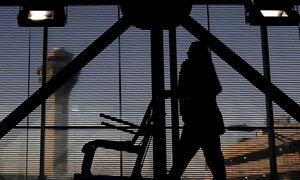The modern effort to “cure” poverty was born when President Lyndon Johnson declared in his 1964 State of the Union address: “This administration today, here and now, declares unconditional war on poverty in America.”
How did that work out and what lessons can and should Mr. Cuomo learn from America’s longest war?
According to a study conducted by the conservative Heritage Foundation, the government has spent $22 trillion of U.S. taxpayer money fighting poverty. “Adjusted for inflation,” Heritage found, “this spending (which does not include Social Security or Medicare) is three times the cost of all military wars in U.S. history since the American Revolution.” And there’s been little to show for it.
The Heritage study concludes that despite all this spending, much of which continues today, the number of people considered below the poverty level remains about the same as when the war began.
Today’s “poor,” the study notes, are much better off than the poor in the mid-‘60s. It notes that among contemporary poor, 80 percent have air conditioning, two-thirds have cable or satellite TV, half own a personal computer and 43 percent can access the internet. In 1964, they might have been called middle class.
Failed government programs have never been a reason to stop repeating the cycle, hoping it will produce different results. Isn’t that the definition of insanity?
가난과의 전쟁이 남긴 교훈
칼 토머스(신디케이트 칼럼니스트)
앤드루 쿠오모 지사는 중부 브루클린의 만성 빈곤문제 해결을 위해 뉴욕의 자산 14억달러를 지출하기를 원한다. 만약 주 의회의 동의를 얻는다면 민주당원인 쿠오모는 가격이 알맞은 주택, 직업훈련, 폭력 퇴치 계획, 오락 공간, 심지어 비만에 그 돈을 지출할 심산이다.
빈곤 “치유”를 위한 현대의 노력은 린든 존슨 대통령이 1964년 연두교서에서 “이 행정부는 오늘 지금 당장 미국의 빈곤과의 무조건적인 전쟁을 선포한다”고 선언했을 때 탄생했다.
그 노력은 어떻게 전개되었으며 미국의 가장 오래 계속되는 전쟁에서 쿠오모가 배울 수 있고 배워 마땅한 교훈은 무엇일까.
보수적인 헤리티지재단의 연구에 따르면, 미국 정부는 빈곤과 싸우는 데 납세자들의 돈 22조달러를 썼다. “인플레를 반영했을 때 이 지출은, 사회보장제도나 혹은 노인의료보험제도를 포함하지 않고도 미국혁명 이후 미국 역사에 기록된 모든 군사전쟁 비용의 3배”란 사실을 이 재단은 발견했다. 그리고 그 대가로 보여줄 성과가 거의 없다.
이 재단의 연구는, 대부분 오늘날에도 계속되는 이 모든 지출에도 불구하고 빈곤선 이하로 간주되는 국민의 수가 전쟁 개시 때와 얼추 비슷하다고 결론 내린다.
오늘날의 “빈민들”은 1960년대 중반의 빈민들보다 형편이 훨씬 더 좋다고 이 연구는 지적한다. 현재의 빈민들 중 80%가 에어컨을 보유하고 3분의 2가 케이블 혹은 위성 TV를 수신하며 절반은 개인 컴퓨터를 소유하며 43%가 인터넷 접속이 가능하다고 보고서는 지적한다. 1964년에는 그런 사람들이 중산층이라고 불렸을 가능성이 있다.
정부의 실패한 계획은, 결과가 다를 것이라는 희망 아래 반복되는 순환의 중단 이유가 된 적이 없다. 그것이 미친 짓의 의미가 아닐까.
역주=오성환 외신전문위원 suhwo@segye.com
△persistent:지속성 있는 △affordable:가격이 알맞은, 입수 가능한
△recreational:레크리에이션의, 오락의 △State of the Union address:연두교서
칼 토머스(신디케이트 칼럼니스트)
앤드루 쿠오모 지사는 중부 브루클린의 만성 빈곤문제 해결을 위해 뉴욕의 자산 14억달러를 지출하기를 원한다. 만약 주 의회의 동의를 얻는다면 민주당원인 쿠오모는 가격이 알맞은 주택, 직업훈련, 폭력 퇴치 계획, 오락 공간, 심지어 비만에 그 돈을 지출할 심산이다.
빈곤 “치유”를 위한 현대의 노력은 린든 존슨 대통령이 1964년 연두교서에서 “이 행정부는 오늘 지금 당장 미국의 빈곤과의 무조건적인 전쟁을 선포한다”고 선언했을 때 탄생했다.
그 노력은 어떻게 전개되었으며 미국의 가장 오래 계속되는 전쟁에서 쿠오모가 배울 수 있고 배워 마땅한 교훈은 무엇일까.
보수적인 헤리티지재단의 연구에 따르면, 미국 정부는 빈곤과 싸우는 데 납세자들의 돈 22조달러를 썼다. “인플레를 반영했을 때 이 지출은, 사회보장제도나 혹은 노인의료보험제도를 포함하지 않고도 미국혁명 이후 미국 역사에 기록된 모든 군사전쟁 비용의 3배”란 사실을 이 재단은 발견했다. 그리고 그 대가로 보여줄 성과가 거의 없다.
이 재단의 연구는, 대부분 오늘날에도 계속되는 이 모든 지출에도 불구하고 빈곤선 이하로 간주되는 국민의 수가 전쟁 개시 때와 얼추 비슷하다고 결론 내린다.
오늘날의 “빈민들”은 1960년대 중반의 빈민들보다 형편이 훨씬 더 좋다고 이 연구는 지적한다. 현재의 빈민들 중 80%가 에어컨을 보유하고 3분의 2가 케이블 혹은 위성 TV를 수신하며 절반은 개인 컴퓨터를 소유하며 43%가 인터넷 접속이 가능하다고 보고서는 지적한다. 1964년에는 그런 사람들이 중산층이라고 불렸을 가능성이 있다.
정부의 실패한 계획은, 결과가 다를 것이라는 희망 아래 반복되는 순환의 중단 이유가 된 적이 없다. 그것이 미친 짓의 의미가 아닐까.
역주=오성환 외신전문위원 suhwo@segye.com
△persistent:지속성 있는 △affordable:가격이 알맞은, 입수 가능한
△recreational:레크리에이션의, 오락의 △State of the Union address:연두교서
[ⓒ 세계일보 & Segye.com, 무단전재 및 재배포 금지]
![[설왕설래] 책 외면하는 사회](http://img.segye.com/content/image/2024/04/18/128/20240418532102.jpg
)
![[현장에선] 총선 그 이후… 민심 되새겨야](http://img.segye.com/content/image/2023/10/04/128/20231004522416.jpg
)
![[세계와우리] 모스크바 테러, 푸틴에 양날의 칼인가](http://img.segye.com/content/image/2024/04/18/128/20240418532116.jpg
)
![[교육의미래] 부모 교육열 적정수준 유지해야](http://img.segye.com/content/image/2024/03/21/128/20240321519812.jpg
)








